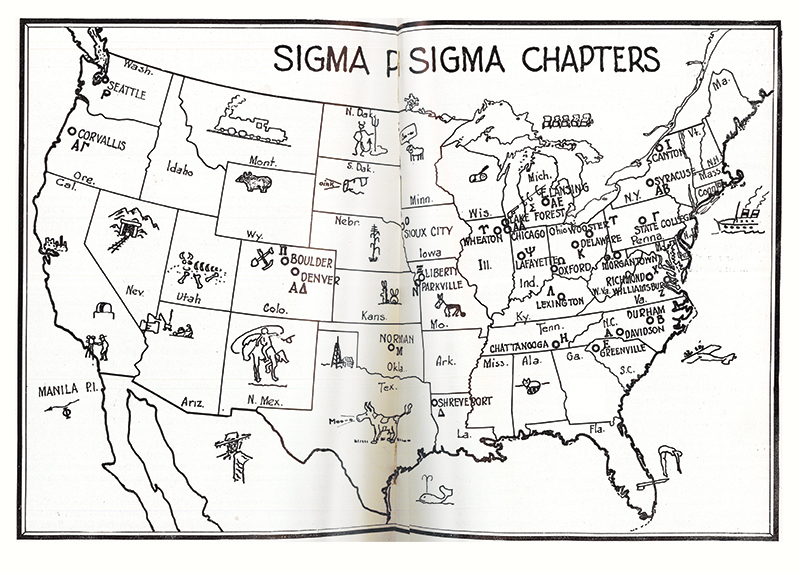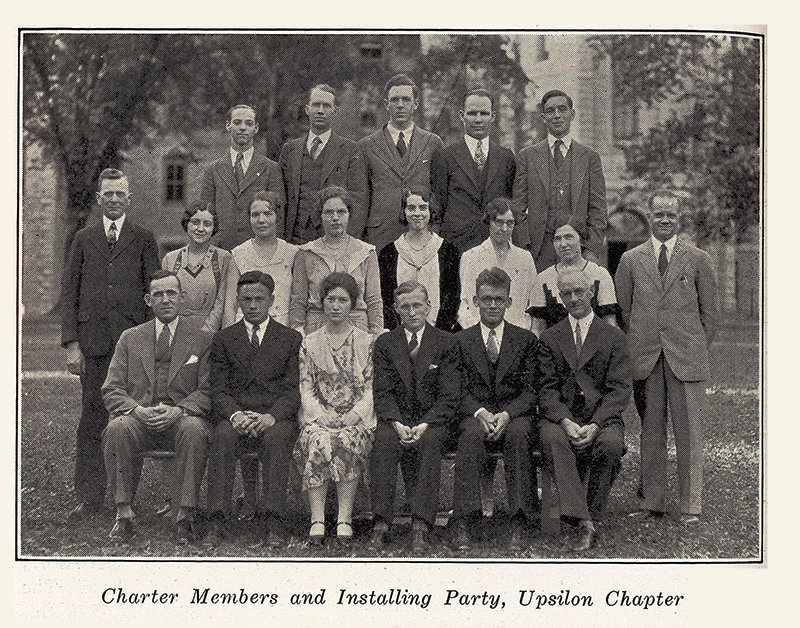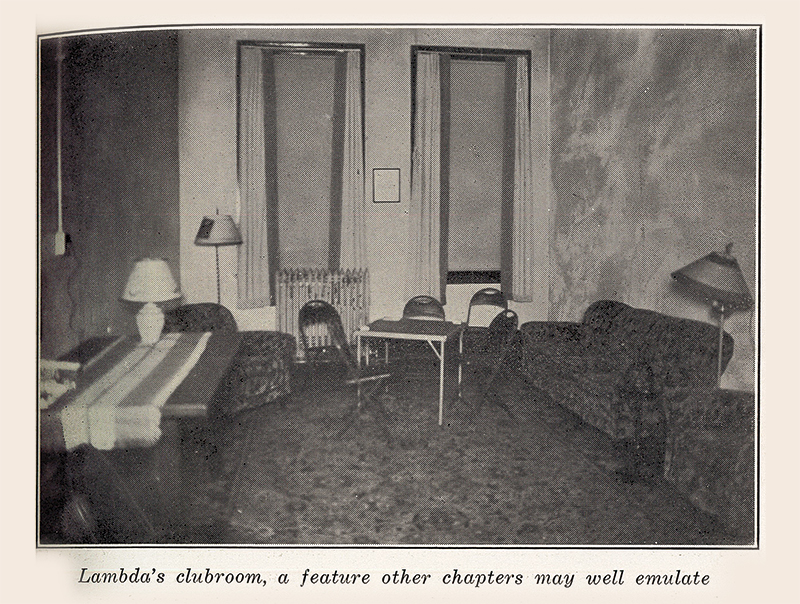Sigma Pi Sigma – A Departmental Legacy of Fellowship (Part 2)
Spring
2020
Unifying Fields
Sigma Pi Sigma – A Departmental Legacy of Fellowship (Part 2)
Brad R. Conrad, Director of SPS & ΣΠΣ
 What is in a name? Sigma Pi Sigma was founded in 1921 at Davidson College as a department-centered group that rewarded “high aim,” encouraged service to the community, and improved departmental fellowship. The benefits of this new society were quite apparent to those that visited Davidson, and the 1920s ended with a rapid expansion of the society which continues to this day.1 Beyond merely adding additional chapters, this period was a phase transition of sorts, as the composition of the society began to shift from a few schools in close communication with each other to a much wider-reaching initiative spanning graduating cohorts. There became a need for society discussion and member news to be spread across dozens of schools with hundreds of members, past and present. Many of those graduating needed a mechanism to remain connected to not just their alma mater but each other, which is still the case today.2 To answer the question of how to connect members spanning institutions and generations, the Sigma Pi Sigma Executive Council chose a freely available, member-focused publication which would contain letters from society leaders, community information, and chapter updates.
What is in a name? Sigma Pi Sigma was founded in 1921 at Davidson College as a department-centered group that rewarded “high aim,” encouraged service to the community, and improved departmental fellowship. The benefits of this new society were quite apparent to those that visited Davidson, and the 1920s ended with a rapid expansion of the society which continues to this day.1 Beyond merely adding additional chapters, this period was a phase transition of sorts, as the composition of the society began to shift from a few schools in close communication with each other to a much wider-reaching initiative spanning graduating cohorts. There became a need for society discussion and member news to be spread across dozens of schools with hundreds of members, past and present. Many of those graduating needed a mechanism to remain connected to not just their alma mater but each other, which is still the case today.2 To answer the question of how to connect members spanning institutions and generations, the Sigma Pi Sigma Executive Council chose a freely available, member-focused publication which would contain letters from society leaders, community information, and chapter updates.
Below is an excerpt of an editorial from the first issue of the Radiations of Sigma Pi Sigma, which was published in October of 19303 and written by Dr. Marsh White himself4:
“Our selection of the name the Radiations of Sigma Pi Sigma for this magazine is purely provisional and subject to change. It seemed appropriate to us. What is your reaction? One of our prominent and greatly interested members wrote some time ago concerning this designation: ‘No more happy title was ever chosen for a journal. Only a physicist can realize the significance of the symbolism. Yet it is obvious that from such an organization as Sigma Pi Sigma there are always these intimate penetrating rays that pervade our entire being and our laboratories. They are invisible; they may be unnoticed by an outsider; but they affect every moment of our life. They arise from electronic encounters from sparks within ourselves and between the members of the fraternity. A laboratory in which the fraternity is organized is never inactive and never at a low potential but is alive at the core. The attendant phenomena are numberless; the production and consumption of energy is tremendous and from those transformations of energy arise new theories, new concepts and new vigor. But most striking is the fact that we all live and breathe in an atmosphere which is vibrating at a high frequency and in which we all have luminous fluorescent faces activated by the radiations of Sigma Pi Sigma. Such an atmosphere is the most precious asset of any university.’”
The field has changed greatly since this was written in 1930, but the atmosphere in which physics departments flourish largely remains the same. Our undergraduate studies affect us deeply, forever changing how we approach the world; however, it is our interactions with each other, our “luminous fluorescent faces” that often have the longest impact.
If SPS and Sigma Pi Sigma were not created when they were, they would have been reinvented to fulfill a fundamental need within physics and astronomy departments: a desire to academically excel, aim high, and share in the pleasure of discovery with colleagues. This speaks to the unique place our organization occupies within departments and for students across a century, as SPS is for many students their first support network and their entry into the broader physical sciences.
The field has changed through the decades, and the work of Sigma Pi Sigma chapters has developed with the times. There is evidence of the first SPS/ΣΠΣ lounge, a closely guarded tradition for many departments, as far back as 1930 at the University of Kentucky.5 To quote the chapter historian, “All are rightfully proud of this ‘social center’ in the department. It serves a purpose which is very essential to the lives of all, even the physicists.”5 And, knowing how student spaces go, the couch featured in the Lambda chapter photo might have been repurposed and still in use in an SPS lounge somewhere else to this day.
As the membership became more diverse, so too did its founding principles. While some groups did not induct women at the time of the founding, Radiations of Sigma Pi Sigma provides us with many examples of Sigma Pi Sigma chapters doing just that, spanning back to our first chapters.6 Additionally, the first female editor of the publication, Vivian Johnson of Purdue University, was announced in the October 1937 issue.7 Through deliberation with the broader collection of chapters, induction criteria for service were strengthened and the pillars of our society became to honor outstanding scholarship in physics, to encourage interest in physics among students at all levels, to promote an attitude of service of its members toward their fellow students, colleagues, and the public, and to provide a fellowship of persons who have excelled in physics. As Sigma Pi Sigma grew, it strived to represent the living ideals and needs of our entire community.
As our understanding of the physical world and the structure of the universe has become more specialized, our need for cooperation and collaboration with each other is stronger than ever. After World War II, the explosion of students at American universities created new challenges and a wealth of opportunities for the honor society that ultimately resulted in the formation of the Society of Physics Students and its intrinsic linkage to the physics honors society. Today, the Society of Physics Students is a home to everyone with an interest in physics and astronomy, while Sigma Pi Sigma continues to honor excellence, service, and fellowship across the generations. It’s the combination of societies that allows us to rely on each other more than ever to collaborate, communicate, and form the communities that will propel each other toward another 100 years of momentum.
Read Part 1: www.sigmapisigma.org/sigmapisigma/radiations/spring/2019/reenergizing-sigma-pi-sigma-call-action


References
- Sigma Pi Sigma, the Physics Honors Society Information Booklet, 3rd ed. (1946).
- J. Pold and P. Mulvey, Physics Bachelor’s One Year After Degree (College Park, MD: AIP Statistical Research Center, 2016), 3.
- Marsh White, “Editorial: What’s in a Name?” Radiations of Sigma Pi Sigma 1, no. 1 (Oct 1930): 20.
- Video Interview of Sigma Pi Sigma icon March White, www.youtube.com/watch?v=4eyRu_QrRXg.
- H. M. Sullivan, “Sigma Pi Sigma Club Chapter Room at Lambda Chapter,” Radiations of Sigma Pi Sigma 1, no. 2 (Dec 1930).
- Alphabetical Membership Directory, Sigma Pi Sigma Bulletin, Radiations of Sigma Pi Sigma 1, no. 1 (Oct 1930).
- “Editor of the Radiations of Sigma Pi Sigma by Executive Committee,” Radiations of Sigma Pi Sigma 8, no. 1 (Oct 1937): 53.
